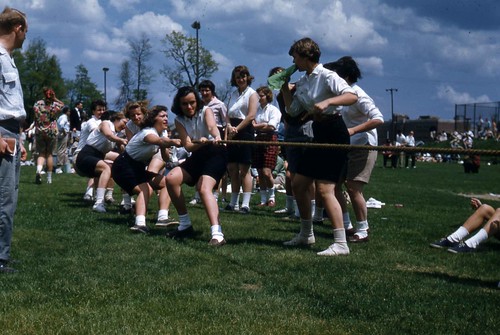In addition to lovely comments from our presenters, exhibitors, and attendees, the Windsor Patch posted this great review of the first ever Connecticut Book Festival. Many thanks go to everyone involved, especially to the wonderful authors and presenters, volunteers and workers, food vendors, exhibitors, performers, therapy dogs and their friends, and of course the attendees who came out to enjoy the Festival. Special thanks go to Bill Thomson for judging our Sidewalk Chalk contest and generously providing signed posters to loads of kids (some bigger than others), and for handing out four copies of his book Chalk to contest winners. The Mystic Paper Beasts were also a hit with children of all ages.[slideshow]
Connecticut Book Festival this weekend!
The countdown is on for the CT Book Festival this weekend! The weather will be great, there are lots of wonderful authors and panels to hear, there will be tons of books for sale and all sorts of stuff for kids to do, too. See you at Book Fest!
Connecticut Book Festival this weekend!
The countdown is on for the CT Book Festival this weekend! The weather will be great, there are lots of wonderful authors and panels to hear, there will be tons of books for sale and all sorts of stuff for kids to do, too. See you at Book Fest!
A traveling exhibit “travels” back home — All in a Day’s Work: Photographs of Women in Connecticut Industry

Women employees at the Cheney Brothers Silk Manufacturing Company mill in Manchester, Connecticut, ca. 1925.
You are cordially invited to the Dodd Research Center to view the exhibit “All in a Day’s Work: Photographs of Women in Connecticut Industry from the Collections of the Thomas J. Dodd Research Center,” now available in the West Corridor until the end of June. The exhibit, which shows photographs from the Business Collections, was the brainchild of UConn Waterbury campus librarian Shelley Goldstein, who developed the exhibit to travel around the regional campuses (and hopefully to other venues) and to promote library outreach. The exhibit opened in Waterbury in March and then it spent the month of April at the Avery Point campus. It is now in Storrs for the summer (at the DRC first and then in the Homer Babbidge Library in July and August) before completing the rounds at the regional libraries through the fall.
You can find all of the photographs in the exhibit, plus the travel schedule, at http://doddcenter.uconn.edu/exhibits/days_work/index.htm.
Laura Smith, Curator for Business, Railroad and Labor Collections
Ruth Plumly Thompson 1939 “Oz” Book Donated to NCLC
Neill wrote three Oz books after Thompson resigned from writing the series in 1939. The story contains the original characters, Dorothy Gale, the Tin Woodman, the Scarecrow, and the Cowardly Lion and of course the Wizard of Oz. Jellia Jam (“Jamb” in the original Baum) is the Wizard’s “pretty little serving maid” who does not appear in the movie version. The Soldier with Green Whiskers and Nick Chopper join everyone for a dinner party at the Wizard’s home so the Wizard can show off his new inventions, two Ozoplanes named Ozpril and Oztober. The Soldier, Tin Woodman, and Jellia board the Oztober and through the Soldier’s bad luck, take off through the roof on a long adventure.
–Terri J. Goldich
May 2011 Item of the Month: Ruth Plumly Thompson’s 1939 “Oz” Book Donated to NCLC

Ozoplaning with the Wizard of Oz (Chicago: Reilly & Lee, 1939). By Ruth Plumly Thompson, illustrated by John R. Neill.
Neill wrote three Oz books after Thompson resigned from writing the series in 1939. This story contains the original characters, Dorothy Gale, the Tin Woodman, the Scarecrow, and the Cowardly Lion and of course the Wizard of Oz. Jellia Jam (“Jamb” in the original Baum) is the Wizard’s “pretty little serving maid” who does not appear in the movie version. The Soldier with Green Whiskers and Nick Chopper join everyone for a dinner party at the Wizard’s home so the Wizard can show off his new inventions, two Ozoplanes named Ozpril and Oztober. The Soldier, Tin Woodman, and Jellia board the Oztober and through the Soldier’s bad luck, take off through the roof on a long adventure.
–Terri J. Goldich, Curator, Northeast Children’s Literature Collection
Announcing a new digital project
A new project to digitize TV interviews by Billie Levy featuring authors, illustrators, editors, and collectors in the field of children’s literature is now available . They are from the “Children’s Books: Their Creators and Collectors” series filmed at WHC-TV. Go to http://www.lib.uconn.edu/services/video/streams.php and scroll down, or go the web page at http://www.lib.uconn.edu/services/video/levy.php. There is also a link from the NCLC’s web site at http://nclc.uconn.edu.
This project was made possible by the generosity of Susan Aller of West Hartford, in honor of our Miss Billie. The project was also made possible by West Hartford Community Television. Ms. Aller is the author of more than a dozen biographies for young people, including the stories of J. M. Barrie, Florence Nightingale, George Eastman, Louisa May Alcott, and Mary Jemison. She has worked as a magazine editor in New York City, and her essays on a variety of topics have appeared in The New York Times, Christian Science Monitor, and other publications. Ms. Aller is a graduate of the University of Nebraska at Omaha, and lived for extended periods in Spain and France, before coming to Connecticut in 1979. As a collector of antique children’s books, she has been an active supporter of the Northeast Children’s Literature Collection at the Thomas J. Dodd Research Center at the University of Connecticut in Storrs. She participates weekly in a long-standing writers’ group and is a member of the Saturday Morning Club of Hartford, a women’s writing group founded in 1876. Ms. Aller is the mother of two married sons and has six grandchildren.
–Terri J. Goldich
Welcome!
The Northeast Children’s Literature Collection (Archives & Special Collections, Thomas J. Dodd Research Center, University of Connecticut Libraries) announces a new blog to bring you news about the Collection, the Archives, and more.
Happy 40th Birthday, Amtrak!

Amtrak's train 83 rounds curve as it kicks up the fresh snow at Old Saybrook, Connecticut. Photograph by Robert LaMay, January 2011.
For more inforamation about Amtrak’s 40th anniversary and National Train Day on May 7, visit http://www.nationaltrainday.com/turning-40/. For more information about the Railroad History Archive, visit http://railroads.uconn.edu/
Laura Smith, Curator for Business, Railroad and Labor Collections
University of Connecticut in Kodachrome
University of Connecticut in Kodachrome, a set on Flickr.
We are very curious about this and what it will look like. Here is a set of Kodachrome photographs from the archives for your viewing pleasure.
Sigma Chi Derby Day, University of Connecticut, 1950s

Sigma Chi Derby Day, University of Connecticut, 1950s, a photo by Archives at the Thomas J. Dodd Research Center on Flickr.
We are testing out our new flickr photostream. Hang in there, we’ll get it all working soon!
James Klar Photograph of the Old Saybrook switch tower

Old Saybrook, Connecticut, switch tower, on the New Haven Railroad. Photograph taken by James S. Klar, 1975.
James S. Klar spent his working life as a city planner, but his first love was photography. After he retired he indulged in his passion full-time, and received training in photography techniques. In 1975 he received a grant from the Connecticut Commission on the Arts to photograph 75 railroad stations in southern New England for an exhibition. This photograph of the Old Saybrook Interlocking, or switch, tower, was taken on June 10, 1975, for the exhibition.
James Klar died in 1985 and in 1990 his wife Marjorie donated the photographs from the exhibition to the Railroad History Archive at the Dodd Research Center. The photographs show exquisite details of old railroad stations and structures, many of them dilapidated.
The interlocking tower in Old Saybrook was built in 1912, for the New York, New Haven & Hartford Railroad. An interlocking, or switch, tower was an important feature for railroad safety. It allowed the tower operator to communicate with railroad personnel about train movements, and to control junction switches and signals with a bank of levers on the second floor. In the 1920s the mechanical interlocking was replaced by banks of electrical relays, which were replaced by pneumatic assists. By the 1970s changes in dispatching technology rendered the tower obsolete and it was closed. The tower was razed in June 1998.
This photograph of the switching levers on the second floor of the tower was taken in 1997 by Robert Brewster when it was recorded for a Historic American Buildings Survey, which you can find in the Connecticut Historic Preservation Collection at the Dodd Research Center.
Laura Smith, Curator for Business, Railroad and Labor Collections





























